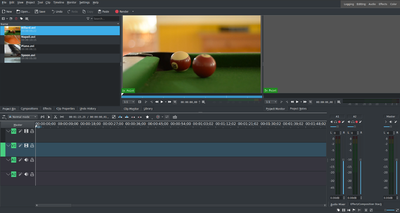Kdenlive/Manual/QuickStart
Creating a new project

The first step is creating a new (empty) folder for our new project. Then get some sample video clips, or download them from here: kdenlive-tutorial-videos-2011.tar.bz2 (7 MB), and extract them to e.g. a Videos subfolder inside the project folder.
Open kdenlive and create a new project (File > New).
Chose the previously created project folder and select an appropriate project profile. The video files provided above are 720p, 23.98 fps. If you are using your own files and don’t know which one to use, kdenlive will suggest an appropriate one when the first clip is added, so you can leave the field on whatever it is.
Adding clips

Now that the project is ready, let’s start adding some clips. This works via the Project Tree widget; A click on the Add Clip icon directly opens the file dialog, a click on the small arrow shows a list of additional clip types that can be added as well. Video clips, audio clips, images, and other kdenlive projects can be added via the default Add Clip dialog.

After loading the clips, kdenlive will look about like this. On the top left there is the already known project tree. Right of it are the monitors that show video; The clip monitor displays video from the original clips, the project monitor shows how the output video will look like, with all effects, transitions, etc. applied. The third, also very important, item is the timeline: This is the place where the video clips will be edited. There are two different types of tracks, Video and Audio. Video tracks can contain any kind of clip. Audio tracks as well – but when dropping a video file to the audio track, only the audio will be used.

Let’s save the work via File > Save. This saves our project, i.e. where we placed the clips on the timeline, which effects we applied, and so on. It can not be played.[1] The process of creating the final video is called Rendering.
Timeline
References and notes
- ↑ To be correct, it can be played using
melt yourproject.kdenlive, but this is not the way you would want to present your final video since it is (most likely) too slow.

